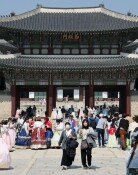4 out of 10 Real Estate Taxpayers Have One House per Household
4 out of 10 Real Estate Taxpayers Have One House per Household
Posted March. 17, 2007 07:43,
Only 160,000 households, or 1.6 percent, are required to pay the comprehensive real estate holding tax. Households with one house with a declared value under 600 million won are not under any burden created by this policy, said former Deputy Prime Minister and Minister of Finance and Economy Han Deok-soo as he announced the governments 8-31 real estate policy in 2005.
The comprehensive real estate holding tax, which was adopted by the government to target the well-off in real estate in Gangnam, Seoul, has designs on the pockets of the middle class. The tax is to be imposed upon many ordinary salarymen with only one house, and non-Gangnam residents are being included on the list of those who have to pay the tax.
According to the Ministry of Finance and Economy on March 16, the number of people with one house who will have to pay the tax doubled from 68,000 last year to 139,000 this year.
The percentage of those with one house who are required to pay the tax also rose from 28.7 percent to 36.5 percent. 4 out of 10 of those are owners of only one house.
In The Forecast on the Comprehensive Real Estate Holding Tax in 2007 it published on March 15, the government omitted a change in the percentage of taxpayers with one house and only explained that, The ratio of houses owned by multiple homeowners is 89.4 percent. This can mislead the readers into understanding that 9 out of 10 payers of the tax are multiple house owners.
The percentages of houses categorized by price illustrate the trend in which the middle class is paying more and more of the tax.
The total number of owners of houses with a declared value between 600 million and 700 million won is 118,000, which is a number 76 percent higher than that of last year (67,000). The ratio of houses priced between 600 million and 700 million won out of all the houses covered by the tax also rose from 28.3 percent to 31.1 percent.
On the contrary, the ratios of houses priced between 700 million and 800 million won, and of those priced above one billion won, fell from 20.2 percent to 17.5 percent and from 28.7 percent to 24.3 percent, respectively.
A person related to a private research institution who requested anonymity said, The standard of taxation should be elevated in relation to the amount the prices of houses rose.
The taxation share of non-Gangnam residents is also growing.
Statistics on the taxed population in each region show that the ratio fell in Gangnam-gu to 15.5 percent from 19 percent last year. The ratio in neighboring regions, such as Seocho-gu, fell from 11.8 percent to 10.9 percent. The ratio in Songpa-gu fell from 10.1 percent to 8.9 percent.
But the share of taxpayers in Goyang-si (including Ilsan New City) rose from 2.5 percent to 4.2 percent, and the population hit with this tax also grew in most areas, including Daejeon, Daegu, Gwangju, and Busan.
With the property tax imposed on houses priced under 600 million won expected to rise from next year, it is anticipated that the whole nation will be burdened by heavy taxation. The ratio of the assessment standard applied to the property tax, which is 50 percent currently, will be adjusted upward to 100 percent by 2017.
koh@donga.com
Headline News
- Ruling, opposition parties to set up their election committees
- Financial authorities set to support auto industry
- LG's Arizona plant to produce cylindrical batteries from next year
- Yoon removed from office by unanimous court decision
- Constitutional Court mentions responsibility of both Yoon and National Assembly







